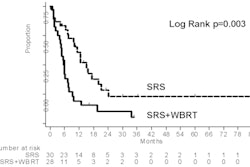Adjuvant radiation therapy (RT) following surgical hysterectomy significantly improves the odds of survival for women who have stage II endometrial cancer, according to a new study.
Based on statistical analysis, women who had surgery alone without radiation therapy were 48% more likely to die, according to results of an analysis of 16 years of data from the National Cancer Institute (NCI) Surveillance, Epidemiology, and End Results (SEER) database by researchers at the Columbia University College of Physicians and Surgeons in New York City.
The management of stage II cancer following extrafascial (simple) or radical hysterectomy is considered controversial, and the value of external-beam radiation therapy to improve survival is not well defined. This study, published in the April 2009 issue of the American Journal of Obstetrics & Gynecology (Vol. 200:4, pp. 419.e1-419.e7), provides a statistical evaluation.
The researchers used the SEER database to identify a total of 1,577 women diagnosed with stage II endometrioid adenocarcinomas of the uterus who underwent surgical management with hysterectomy and staging lymphadenectomy between 1988 and 2004. Seventy-six percent (or 1,198) had a simple hysterectomy and 24% (379) had a radical hysterectomy, according to lead author Dr. Jason Wright.
External-beam radiation and/or brachytherapy was administered to 56% of women who had a simple hysterectomy and to 57% of women who had a radical hysterectomy. The women who had radical hysterectomies had a higher lymph node count (a median of 15 versus 13), and 69.4% of these patients had stage II not otherwise specified (NOS) tumors, compared to 17.6% of the women who had a simple hysterectomy.
The five-year survival rate was 79% for women who underwent simple hysterectomy and 82% for women who had a radical hysterectomy.
The researchers determined the following:
- Radical hysterectomy had no apparent effect on survival.
- Women in the entire cohort who did not receive radiation therapy were 48% more likely to die than those who did.
- Women who had a radical hysterectomy but did not receive radiation therapy were 88% more likely to die than those who did.
- Women with cervical stromal involvement (stage IIB) were significantly more likely to die from their tumors than those with only glandular involvement (stage IIA).
White and colleagues also reported that women treated in the later years of the study were less likely to undergo radical hysterectomy and less likely to receive adjuvant radiotherapy.
Related Reading
Lymphadenectomy and radiotherapy not useful for early endometrial cancer, December 15, 2008
Vaginal brachytherapy effective for endometrial cancer, June 3, 2008
Toxicity levels with gynecologic chemoradiation deemed acceptable, November 28, 2007
Copyright © 2009 AuntMinnie.com



















